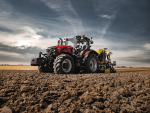Research intended to reduce ‘wastage’ in commercial ewe flocks has begun at Massey University. The trial involves two commercial ewe flocks – at least 12,000 animals.
The aim of the project says Professor Paul Kenyon, head of Massey’s Institute of Veterinary, Animal, and Biomedical Science, is to define characteristics in a ewe that farmers can use to determine which sheep to cull, which need more input to prevent them ‘falling’ out of the flock and which ones to keep.
Kenyon says the project should provide risk factors on which farmers can base decisions about which ewes to keep or cull. The most productive ewe is one that stays in the flock for many years and continues to rear lambs.
The project is led by the recently appointed sheep and beef health lecturer at Massey, Kate Griffiths, until recently a vet in Taumarunui. Griffiths is doing a doctorate based on this project. It also includes Professor Cord Heuer and Drs Rene Corner and Anne Ridler.
Griffiths says little research has been done on this subject recently. And farmers say they’d like to know more about what are, in some cases, unexplained sheep deaths and poor production levels in others.
Griffiths says the project started with 12,000 tagged hoggets and their progress was followed by recording data on them at least four times annually for some years.
“So wastage is basically culling prematurely – before the end of their productive life span. A lot of people cull based on age, [perhaps] at six years old; but the question is ‘can they be kept for longer or should they be culled earlier, and what sort of factors influence that? There is little information about that.
“When I left Taumarunui all the farmers wondered what I was going to do, and when I told them, they thought it would be a fantastic idea.”
Griffiths says so far a few criteria have emerged, such as if a hogget is mated under 40kg she has a much lower longevity than one that’s heavier. A low condition score at a young age can have a massive impact on the likelihood of a ewe staying in the flock.
“So if they are less than BC 2.0 they have reduced longevity and are more likely to be culled or to die. It looks as though once a hogget is mated at under 40kg it never picks up condition in its lifetime and it has a lower lifelong performance.”
If a hogget is under 40kg it shouldn’t be mated but instead fed so that it gains weight for mating the following season. Research has shown BC 3.5 as the ideal condition score for mating. At that number the animal should perform well in all aspects of reproduction.
Notably, the trial is in commercial, not research, flocks. Professor Paul Kenyon says the aim is collect data which can be readily applied by farmers.
“In the case of a research flock, there is a danger the animals might be slightly pampered. The same could also possibly be said of a breeding flock. That’s why we’ve deliberately chosen commercial flocks for this project.”
Kenyon says the trial is also limited to Romney-based composite breeds. He says it would be impossible to do the research across all breeds.
“Interestingly, we did a farmer survey recently which showed that in New Zealand there are 150 ‘composite breeds’ – which is quite a lot.”
He says the research project can deliver financial benefits to farmers because wastage in sheep flocks costs farmers money. This occurs when sheep die and when they suffer poor health. All this means farmers must carry more replacement stock and face greater costs getting their animals well again.
Another flock wanted
Massey is looking at incorporating another flock into the trial, ideally near Massey University. This will enable vet Kate Griffiths to use her skills to determine the cause of death in some sheep.
“That means I can do post mortems on animals dying; one problem we have is some sheep are just ‘missing’. These are not being identified as definitely dead and it would be nice to know what they’re dying of.”
Kenyon says this research is timely given the way the country’s ewe flock has changed over 20 years.
“Twenty years ago singletons were ok and we weren’t breeding hoggets. Now we’re putting more pressure on them to be multiple-bearing and on many farms they’re being breed as a hogget and we want all ewe age classes to wean heavier lambs.
“So we’re putting more pressure on the ewe and the question is ‘can she handle that?’. It’s a bit like what was happening to the dairy industry. Look at our Friesian cow 20 years ago, she was slightly different from what we have now, and you could argue the same is happening now to the ewe flock.”



















